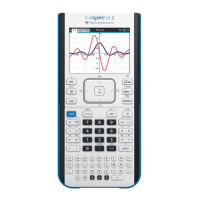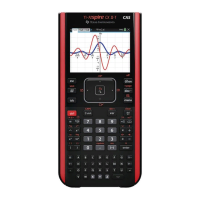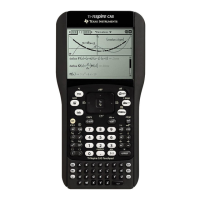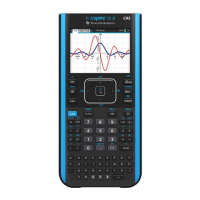14 TI-Nspire™ Reference Guide
C
4Base16
Catalog
>
Integer1
4Base16 ⇒ integer
Note: You can insert this operator from the computer keyboard by
typing @>Base16.
Converts Integer1 to a hexadecimal number. Binary or hexadecimal
numbers always have a 0b or 0h prefix, respectively.
0b binaryNumber
0h hexadecimalNumber
Zero, not the letter O, followed by b or h.
A binary number can have up to 64 digits. A hexadecimal number can
have up to 16.
Without a prefix, Integer1 is treated as decimal (base 10). The result
is displayed in hexadecimal, regardless of the Base mode.
If you enter a decimal integer that is too large for a signed, 64-bit
binary form, a symmetric modulo operation is used to bring the value
into the appropriate range. For more information, see
4Base2,
page 12.
binomCdf()
Catalog
>
binomCdf(n,p) ⇒ number
binomCdf(n,p,lowBound,upBound) ⇒ number if lowBound
and
upBound are numbers, list if lowBound and upBound are
lists
binomCdf(
n,p,upBound) for P(0{X{upBound) ⇒ number if
upBound is a number, list if upBound is a list
Computes a cumulative probability for the discrete binomial
distribution with n number of trials and probability p of success on
each trial.
For P(X { upBound), set lowBound=0
binomPdf()
Catalog
>
binomPdf(n,p) ⇒ number
binomPdf(n,p,XVal) ⇒ number if XVal is a number, list if
XVal is a list
Computes a probability for the discrete binomial distribution with n
number of trials and probability p of success on each trial.
ceiling()
Catalog
>
ceiling(Val ue 1) ⇒ value
Returns the nearest integer that is | the argument.
The argument can be a real or a complex number.
Note: See also floor().
ceiling(List1) ⇒ list
ceiling(Matrix1) ⇒ matrix
Returns a list or matrix of the ceiling of each element.

